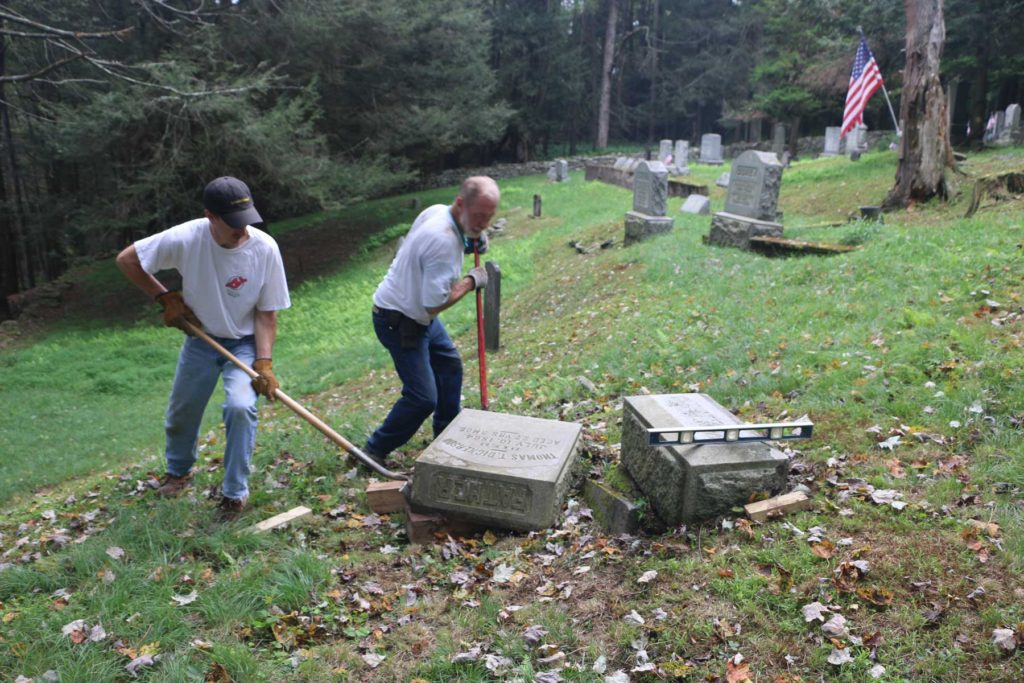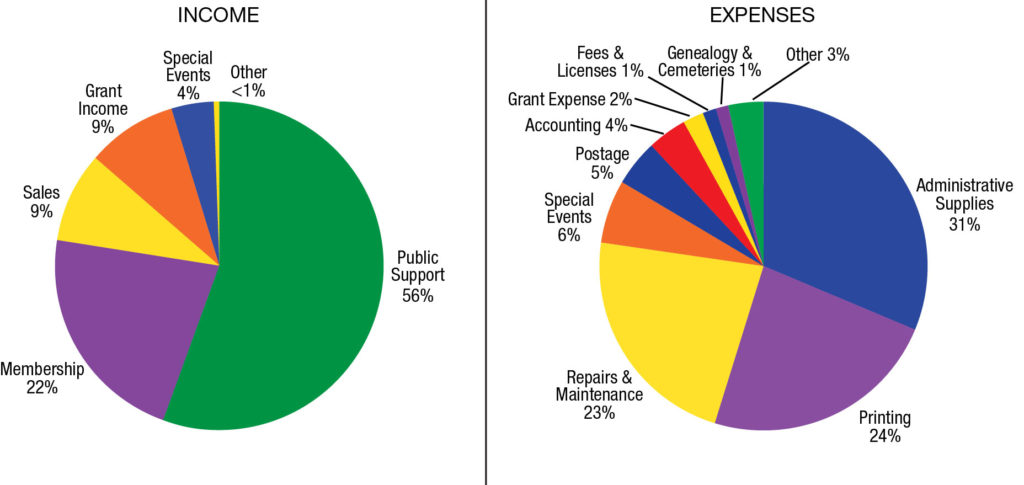View the Society’s 2018 Annual Report — —
MESSAGE FROM THE PRESIDENT
Each year our annual report is an opportunity to acknowledge and celebrate you—our donors, volunteers, and partners who give so generously of your time and energy. It’s because of you that we’re able to offer educational programs and workshops for people of all ages. Because of your generous donations of artifacts, photographs and documents, we are able to create exciting new exhibitions and host museum tours to showcase our growing collections. With your support and participation, we can continue our research and writing on engaging topics that tell the story of our community. The time and talent that you share throughout the year are much needed and much appreciated—it creates the fabric of this organization. We sincerely thank you and invite you to contact us anytime to share your ideas, suggestions, or goals for the future of the Historical Society. —Jeanne Brown
BUSINESS AND COMMUNITY PARTNERSHIPS
Business Partners — We welcomed 20 local businesses as our 2018 Business Partners. With their generous support we were able to host a variety of educational programs and workshops, exhibitions and museum tours, open houses and special events—all offered free to members, guests and visitors of all ages.
Wallenpaupack South Elementary School — In partnership with Wallenpaupack South Elementary School in Newfoundland, the Society coordinates local history programs for third and fourth grade students, including:
- “Local History Day” for fourth grade students, featuring stations where students try their hand at using historic farm tools and household implements, and local history curriculum materials for both students and teachers.
- “Mysteries at the Museum,” for 3rd and 4th grade students with interactive stations.
- “Food Preservation—From Salt to Canning Jars,” presented by Quiet Valley Living Historical Farm for third grade students, with hands-on demonstrations.
- “Farming = Good Food,” a permanent exhibition in the lobby of the school, which illustrates where our food comes from—from planting and harvesting to processing and preserving.
Boy Scouts and Girl Scouts — We host local Scout groups at the museum for special events, such as the Flag-Rasing Ceremony at our annual Open House in July.
Newfoundland Public Library — In cooperation with the library, we offered genealogy workshops on-site to assist participants with their research using the tools available at the library, such as Ancestry.
Greene-Dreher Alumni Association — In partnership with the GDAA, we host alumni events at the museum each June in honor of the graduating seniors and the 50th Reunion class. We are also the repository of the Association’s historic documents and photographs.
NEW PUBLICATIONS
GDHS website — The Society launched a new website in the spring of 2018 designed to be user-friendly and easily accessible. In addition to our calendar of events and current and past newsletters, the site offers many new features, including virtual exhibitions, local history articles and resources, and a gallery of historic photographs.
Mills on the Wallenpaupack—South and East Branches, by Diane Smith, published in 2017, traces the development of the area’s first industries, the water-powered gristmills, sawmills and turning factories.
Historic Cemeteries of the Wallenpaupack Valley, by Ruth Altemier, with photographs and summaries of ten historic cemeteries in the area, including an updated map and self-guided driving tour.
GDHS Newsletter — Our quarterly newsletter features highlights and photographs of recent events and keeps members and friends up-to-date on all the news of the Society.
The Greene Hills of Home — Our triannual journal includes memoirs, oral histories, essays and scholarly articles on a variety of topics related to local history. The journal is mailed to all members.
2018 HISTORIC PRESERVATION AWARDS
At the tenth annual Holiday Luncheon in December, held at the Fairway Grille at Buck Hill, we presented our 2018 Historic Preservation Awards to:
Ben and Kathy Nevin — For researching and documenting family genealogies; preserving historic family photographs; authoring articles for the Society’s journal; donating local artifacts; and conducting research in support of the Society’s Genealogy Committee and the Veterans History Project.
Kay Logan, Genevieve Reese and Bridget Weber — For preserving the historic Hirshhorn estate, known as The French Manor, in South Sterling. Built in 1935, the property has been owned by the Logan family since 1990 and operated as an full-service country inn. They have researched its history, which they share with guests, and have undertaken careful restoration to preserve the architectural integrity of the buildings.
TELLING OUR STORIES…
One of the most important goals of the Historical Society is to tell the story of our community from its earliest days. To that end, we maintain a museum with changing and permanent exhibits, offer public lectures, arrange group tours and activities, operate a genealogy research center, and publish articles and books on local history. Over the past year, we have improved access, added to our collections, increased public workshops, and connected more people than ever to history. Below are highlights of events, exhibitions, and community programs offered free to the public in 2018.
Museum & Collections
Exhibitions
Exhibitions at the museum shed light on important episodes from our past and engage people of all ages. In addition to semi-permanent displays that showcase the domestic arts and fraternal organizations around the turn of the last century, new exhibitions focussed on:
Greene-Dreher High School, 1901–2000 — A new wall display in the meeting hall celebrates 100 years of high school history, from the first two-year high school built in 1901 to the present-day Wallenpaupack High School. The display features a timeline poster with highlights and photographs from each decade and school memorabilia from the GDHS archives.
Greene-Dreher in The Great War — An exhibition honoring local World War I veterans commemorated America’s participation in the World War in 1917–18.
Open Houses
At our Open Houses in June, July and October, we offered guided tours of the museum and outbuildings. Special events included:
- Local Author Book Signing
- Jam Session with local musicians
- Demonstration of a 2-cycle engine and how it was used on the farm to power machinery—everything from an ice-cream maker to a corn chopper/blower.
- Flag Ceremony with local Scout troops, in coordination with Patriotic Order Sons of America
Collections
Every year we witness the power of historical artifacts, photographs and documents to connect with and speak to our members and guests, and we believe the collections we hold within our walls will continue to provide meaning and inspiration for years to come. We are grateful for the many significant donations to our collections in 2018—each item is another piece in the fabric of our social history and helps us understand the people who lived here and formed the community we share today.
Educational Programs
Talks by local historians follow a brief membership meeting held each month at Peggy Bancroft Hall, from April through November. Special programs are also offered off-site. Last year we saw an increase in overall attendance at both on-site and off-site programs, totaling approximately 2500 attendees.
Guest speakers
- “The Art and Craft of Book Binding,” by Barry and Hillary Anthony
- “Heirloom Gardening,” by Lou Palazzi
- “Tobyhanna—From Artillery Range to Signal Depot,” by Kristyn Smith
- “The ‘Bear’ Facts,” by John Hechler
- “Antique Fruit and Canning Jars,” by Bob Wood
- “Stories From the Past,” a series of talks given by longtime residents as part of our Oral History Project, continued this year with two guest speakers, Tere DeMelo and Floss Krieger.
- “The Spanish Influenza Epidemic of 1918,” by Ann O’Hara
- “Patriotic Songs Honoring Veterans,” performed by the Wallenpaupack South Elementary School Chorus.
Offsite programs
- Tour of Historic Newfoundland, led by Ruth Altemier, Bernadine Lennon, Tammy Lavoy, and Diane Smith
- “Greene-Dreher’s Glorious May Days,” by Diane Smith
- “Charles Carlton—World War I Veteran and Master Engrosser,” by Bernadine Lennon.
- “Historic Mills of Promised Land,” by Diane Smith
- “Grave Matters: Victorian Funeral Practices,” by John Fetsock of Frey-Fetsock Funeral Home, followed by a Tour and Reenactment at Pine Grove Cemetery by Ellen Drake and Ruth Altemier.
- “Finding Family,” a series of genealogy workshops led by Ruth Altemier, Valerie Wheeler, and Carla Smith, offered at the Newfoundland Public Library.
GENEALOGY AND CEMETERIES
Genealogy
- The Genealogy Committee, in cooperation with the Newfoundland Area Public Library, hosted two series of Genealogy Workshops, free to the public, on how to conduct research and access helpful resources, such as Ancestry, one of the largest resources for online family history and genealogy.
- The Committee maintains a database that includes more than 10,000 individual records and makes it available to the public for educational and research purposes. It also maintains a resource library of family histories.
- A House Inventory Program was implemented to research—through tax records, deeds, maps, and other public records—and document ownership of houses and commercial buildings in the community.
- The GDHS Veterans History Project, implemented in 2017, continues to research and document the military service of our local veterans, from the early 1800s to the present day.
- Genealogical data is cross-referenced to our collection of historical letters, diaries, records and manuscripts to help connect people with their past.
Cemeteries
Cemeteries are among our most valuable archaeological and historic resources. They are evidence of the early settlement patterns and economic development of the region. They reveal the social relationships and religious influences of those who lived here, and many times they represent the only reminder of an influential person, family or group. Of the ten cemeteries within our boundaries, six are no longer active and do not have cemetery associations to provide perpetual care. In 2009 the Greene-Dreher Historical Society implemented a Cemetery Preservation Program for five of the six cemeteries—Gilpin, Hazelton, Wolfe, Simonstown, and Kipptown Cemeteries. The challenge of documenting, restoring and preserving these cemeteries is one of the most complicated endeavors the Historical Society has undertaken. Volunteers with the Society’s Adopt-a-Cemetery Program now care for the grounds on a regular basis. As resources permit, specialized work is being done to repair the grounds and remount and stabilize damaged stones. The Cemetery Committee is also in the process of researching and mapping all ten of the historic cemeteries in the community and making the information available to the public.
Research by Mail
Among the many research requests we responded to recently, three in particular stand out:
- Discovering that an ancestor served during the Revolutionary War and wintered with General Washington at Valley Forge.
- Tracing the story of your house back to its original owners, a couple who emigrated from Germany and who were among the first settlers in the Wallenpaupack Valley in the early 1800s.
- Obtaining historic photographs of the summer boardinghouse where your parents spent their honeymoon in the 1940s.
Cemetery Restoration

FINANCIALS

Income—The majority of the Society’s income was derived from public support, including new and renewing memberships and donations from members, Business Partners, and Greene and Dreher Townships. Most of the remaining income came the sale of the Society’s publications and from grants. We received a $2000 grant from Wayne County Community Foundation and a $1000 grant from Greater Pike Community Foundation, to be used for the purpose of website design.
Expenses—A large portion of our Administrative Supplies expense was the result of a major redesign of our new website, launched in May. Printing costs represent all of the Society’s print materials, including books, journals, newsletters, flyers, brochures, and calendars. Maintaining and repairing our museum buildings made up the third largest expense category.